gocraft/work工作队列源码简介
作者/蔡锡生
简介
gocraft/work是一款使用go开发的任务处理软件,通过redis存储任务队列,可以使用工作池同时处理多个任务。本文主要介绍任务注册和任务消费的源代码。
功能特性
• Fast and efficient. Faster than this, this, and this. See below for benchmarks.
• Reliable - don't lose jobs even if your process crashes.
• Middleware on jobs -- good for metrics instrumentation, logging, etc.
• If a job fails, it will be retried a specified number of times.
• Schedule jobs to hAppen in the future.
• Enqueue unique jobs so that only one job with a given name/arguments exists in the queue at once.
• Web UI to manage failed jobs and observe the system.
• Periodically enqueue jobs on a cron-like schedule.
• Pause / unpause jobs and control concurrency within and across processes.
注册Job
注册Job流程
1. 创建redis client pool。
2. 创建对象,定义任务处理函数。
3. 创建任务工作池,需要传入被处理对象结构体,最大并发数,命名空间,redis client pool。
4. 创建Job,需要传入job名称和job处理函数, job在redis中使用列表存储,key的组成:nameSapce:job:jobName,同一namespace支持多种类型任务处理。
这里使用任务名称作为key存入redis, 任务处理参数存放到列表中
func main() {
// Make a new pool. Arguments:
// Context{} is a struct that will be the context for the request.
// 10 is the max concurrency
// "my_app_namespace" is the Redis namespace
// redisPool is a Redis pool
pool := work.NewWorkerPool(Context{}, 10, "my_app_namespace", redisPool)
// Add middleware that will be executed for each job
pool.Middleware((*Context).Log)
// Map the name of jobs to handler functions
// pool 中的 jobTypes是一个字典,key 是任务名称, value 是 任务处理函数
// 当有任务的时候,会将任务需要的参数 放入到redis key 为jobName的列表中
// 第二个参数必须是 工作池对象的方法
pool.Job("send_email", (*Context).SendEmail)
// Customize options:
pool.JobWithOptions("export", work.JobOptions{Priority: 10, MaxFails: 1}, (*Context).Export)
// Start processing jobs
pool.Start()
...
}
发送Job
发送job其实调用NewEnqueuer方法向redis的列表中压入元素(具体的内容是任务参数)。
package main
import (
"github.com/gomodule/redigo/redis"
"github.com/gocraft/work"
)
// Make a redis pool
var redisPool = &redis.Pool{
MaxActive: 5,
MaxIdle: 5,
Wait: true,
Dial: func() (redis.Conn, error) {
return redis.Dial("tcp", ":6379")
},
}
// Make an enqueuer with a particular namespace
var enqueuer = work.NewEnqueuer("my_app_namespace", redisPool)
func main() {
// Enqueue a job named "send_email" with the specified parameters.
_, err := enqueuer.Enqueue("send_email", work.Q{"address": "test@example.com", "subject": "hello world", "customer_id": 4})
if err != nil {
log.Fatal(err)
}
}
Woker Fetch Job
在New WrokPool的时候会根据并法参数concurrency,创建同等个数的woker。
Worker是一个job处理者,通过永久for循环,不间断的从redis的任务队列中获取任务,在处理任务的时候,协程阻塞,等待一个任务处理完,再继续下一个。
下面的代码是worker在for循环中的重要操作(1) fetch job (2) process job
func (w *worker) loop() {
for {
select {
。。。
case <-timer.C:
job, err := w.fetchJob()
w.process(job)
}
}
}
fetchJob本质是redis的pop,push操作。首先将redis列表中的任务移除,然后再放入到处理队列中,这个操作必须是原子操作(原子性是指事务是一个不可再分割的工作单元,事务中的操作要么都发生,要么都不发生),作者使用了lua脚本完成。最后返回一个job对象,里面有后面任务处理函数需要的args,即这里的rawJson。
func (w *worker) fetchJob() (*Job, error) {
scriptArgs = append(scriptArgs, w.poolID) // ARGV[1]
...
values, err := redis.Values(w.redisFetchScript.Do(conn, scriptArgs...))
...
job, err := newJob(rawJSON, dequeuedFrom, inProgQueue)
..
return job, nil
}
Worker handle Job.
Pool.JobWithOptions(InstallMasterJob, work.JobOptions{Priority: 1, MaxFails: 1}, ConsumeJob)
workpool注册任务ConsumeJob后, 该任务ConsumeJob会被赋值给worker.jobTypes[job.Name].GenericHandler, 他的反射类型被赋值给了jobType.DynamicHandler。如果该消费任务使用了上下文参数。
创建消费任务的2种方法
• If you don't need context:
func YourFunctionName(job *work.Job) error.
• If you want your handler to accept a context:
func (c *Context) YourFunctionName(job *work.Job) error // or,
func YourFunctionName(c *Context, job *work.Job) error.
func (wp *WorkerPool) JobWithOptions(name string, jobOpts JobOptions, fn interface{}) *WorkerPool {
jobOpts = applyDefaultsAndValidate(jobOpts)
vfn := reflect.ValueOf(fn)
validateHandlerType(wp.contextType, vfn)
jt := &jobType{
Name: name,
//vfn 任务消费方法的反射类型, 如果消费方法中有ctx 参数,那么会调用反射执行
DynamicHandler: vfn,
JobOptions: jobOpts,
}
if gh, ok := fn.(func(*Job) error); ok {
// 用户的任务消费函数,被赋值给了jobType的GenericHandler, 如果消费方法只有一个job参数,则执行GenericHandler
jt.IsGeneric = true
jt.GenericHandler = gh
}
wp.jobTypes[name] = jt
for _, w := range wp.workers {
w.updateMiddlewareAndJobTypes(wp.middleware, wp.jobTypes)
}
return wp
}
执行消费任务的真正代码
worker对象的processJob(job * Job)方法 调用了runJob方法执行GenericHandler or DynamicHandler.Call。
func runJob(job *Job, ctxType reflect.Type, middleware []*middlewareHandler, jt *jobType) (returnCtx reflect.Value, returnError error) {
。。。。
next = func() error {
。。。。
if jt.IsGeneric {
// 任务消费方法没有ctx时候执行
return jt.GenericHandler(job)
}
// 任务消费方法有ctx时执行
res := jt.DynamicHandler.Call([]reflect.Value{returnCtx, reflect.ValueOf(job)})
x := res[0].Interface()
if x == nil {
return nil
}
return x.(error)
}
...
returnError = next()
return
}
LStack产品简介
面向行业应用开发商(ISV/SI)提供混合云/边缘云场景下云原生应用开发测试、交付、运维一站式服务,帮助企业采用云原生敏捷开发交付方法论,从而提高软件开发人员效率、减少运维成本,加快数字化转型,并最终实现业务创新。




























